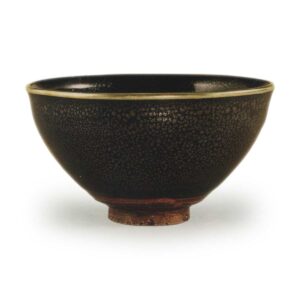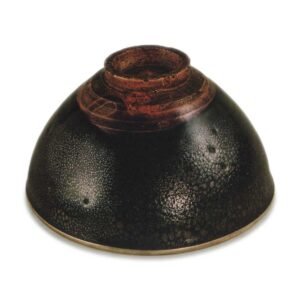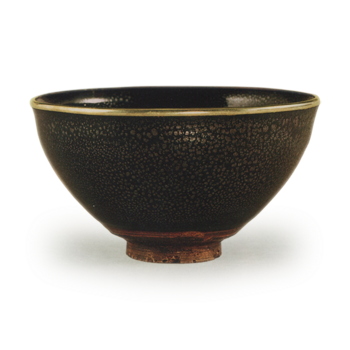

Daimyo-butsu
Tokugawa Art Museum
Height: 7.4-7.6cm
Diameter: 13.4cm
Base diameter: 4.5cm
Height: 0.8cm
According to the Tokugawa family’s tradition, this is a Yohen Tenmoku, but from today’s knowledge, it is more appropriate to call it Yuiteki.
The clay is white and sticky, with a fine texture, and has become darkened with use. The foot ring is large and high, and the inside of the foot ring has also been deeply carved. It is clearly from northern China. It is probably from the same place as the Yuiteki Tenmoku at Ryukoin and the Fujita Art Museum. The overall shape, as seen from the outside, is also quite different from that of the Jian ware, and is more like a normal bowl shape. If we were to classify it by shape, it would be a little difficult to include it in the Tenmoku category, but in the past, it seems that all wares with this type of glaze were collectively referred to as Tenmoku.
As usual, the glaze is a deep black, but it is not as thick and full as the Jian ware glaze.
Even on the parts of the glaze where it has peeled off, you won’t see the kind of puddles of glaze that curl up. This is one of the characteristics of the Tenmoku ware from the north. On the surface of the glaze, there are tiny silver grains with a sepia tinge, known as ‘yudeki’ (oil spots). The oil spots are not all the same size, however, and some are larger than others. In general, they are close to being round. When viewed through a magnifying glass, they can be seen to be made up of small crystals of metal.
On the inside, the oil droplets are evenly distributed. The reason that the grains become finer the higher up the vessel you go is probably due to the curve of the vessel wall, or in other words, the thickness of the glaze. In contrast, the oil droplets on the outside of the vessel are not very evenly distributed. The surface seen in the side view is still well-aligned, but on the other side (the surface in the foot ring view), there is a big difference in size. Furthermore, the glaze looks like it has been boiled, and the luster is dull. It seems that the fire was not strong enough. This is probably why there are holes in the glaze that look like they have been sucked in. In the slightly raised part of the glaze at the bottom, the oil spots do not connect, and only the jet-black glaze is visible.
If you look carefully at the image of the foot ring, you will notice that there is a purple-tinged glaze running from the glaze crack to the foot ring.
This phenomenon is extremely rare, but it is an important key to solving the mystery of Tenmoku glaze. Looking at the raised areas of the glaze on the Tenmoku ware from the Kenmoku kiln, it would appear that the Tenmoku glaze is a single layer, but in fact it is a double glaze.
In other words, a glaze containing iron, such as Kimachi (a type of tuff containing iron oxide that is produced in Shimane Prefecture and used as a glaze ingredient for red roof tiles), is applied to the bottom, and then a thin glaze, such as a light gray glaze, is applied and fired. The upper glaze is applied so that it does not overflow from the lower glaze, and during firing it blends well with the lower glaze, so it is difficult to tell which is which in the finished glaze surface. However, in this teacup, the upper glaze happened to flow slightly and cover the unglazed base. In that respect, it is a truly valuable piece of material.
Incidentally, I should add that the overglaze must probably contain lead. It seems that during the process of firing the tea bowl and the kiln cooling down, reduction occurs, which acts on the lead in the overglaze to create that iridescent (a type of raster) film.
It was originally owned by Tsunayoshi (Jōyū) of Sakai. It was later presented to the shogunate family, and from Ieyasu it was given to Yoshinao of Omi in Sunpu, and is known as the Suruga Goyosei.



